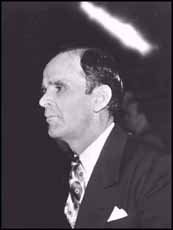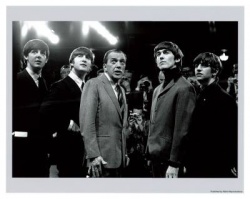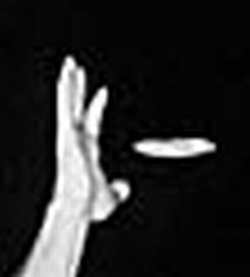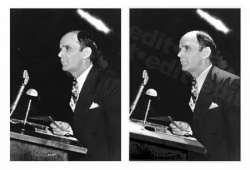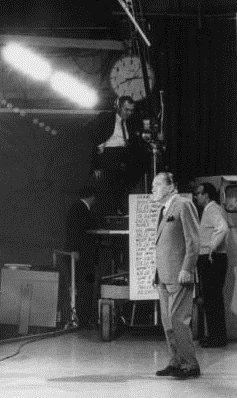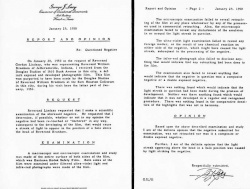The Houston Photograph
A photograph was taken by Douglas Studios of Houston, Texas, on January 24, 1950, of a halo-like light above the head of William Branham. Gordon Lindsay took the negative to George J. Lacy, an Examiner of Questioned Documents, who was asked to determine whether or not the light could have been the result of improper exposure, double exposure, or tampering during the developing process or retouching. A written report was prepared stating that the unusual brightness was caused by light striking the negative.
Message believers are under the impression that this photograph was verified by the FBI, hangs in the Hall of Religious Art in Washington, D.C. and captures a light of supernatural origin.
Do these claims hold up to scrutiny, and is this vindication legitimate?
| They lay on cots under the glare of the great lights of Sam Houston Coliseum Tuesday last night - the lame, the sick, the infirm, the ones whose hopes for physical health had almost gone. They lay there quietly, some of them uncomprehendingly, as the theological argument swirled about and above them. (The Houston Chronicle, January 25, 1950) |
What William Branham said
William Branham said that God would not allow a picture to be developed of Rev. Best pointing his finger at F.F. Bosworth Click here to read a copy of the January 24th, 1950 issue of The Houston Press.
- I seen him the night of the debate when this Angel of the Lord came down and had His picture taken that you see here now, they got of the meeting. It was Brother Bosworth who stood there that night, and this young fellow just out of the seminary, pointing his finger in that old saints face, and having him take his picture like this. And he shaking his fist in that old saintly man's face, and saying, "Now, take my picture. And now take my picture," like that. 'Cause he wanted six pictures taken; he could publish it in his paper in such positions as that. And Almighty God would not permit one of them to be developed. Every one of them was perfect negative. That's right. (Chicago, July 20, 1954)
- So then when he pulled the first picture out of Mr. Best with Mr. Bosworth, it was negative. God wouldn’t permit that taken against that saintly old man. He pulled out the next one: negative. He pulled out all six of them, and every one of them was blank. And when he pulled out the other one, there was the Angel of God on the picture. He had a heart attack.[1]
William Branham also said that it was George J. Lacy who first called it a supernatural light
- Mr. Lacy said it was the first time in all human history that a--a supernatural Being was ever photographed. They said it just a... that it's been said, a lot of times that those lights around the saints, and the unbelievers say that's some artist painted that picture. But said, "It surely must have been there, for that optical lens--mechanical lens of a camera won't take psychology. It was... It was there." (Minneapolis, July 14, 1950)
Facts surrounding the picture
It was during the Houston campaign in 1950, that Rev. W. E. Best (representing the Houston Baptist Pastor's Conference) accused William Branham of racketeering and leading people astray. A public challenge was issued, and F.F. Bosworth accepted a challenge on the subject of "Divine Healing Through the Atonement." While Bro. Branham cautioned Brother Bosworth against being argumentative, the newspapers reported that the two ministers talked at once, and a fist-fight broke out in the audience. The meeting was given front-page publicity in the Houston newspapers.
As the debate got under way, it was quite apparent that the sympathy of the vast audience was almost entirely on the side of the visiting evangelists. Large numbers of members from the same denomination as Rev. Best stood to their feet as witnesses that they believed in Divine healing and had in fact been healed.
We are told that Rev. Best secured the services of Mr. James Ayers and Mr. Ted Kipperman, professional photographers from Douglas Studios in Houston, to document the evening. They were there in addition to the newpaper photographers. After taking several photos of Rev. Best, the photographer snapped a picture of William Branham, who spoke briefly just before the service closed.
There are some specific facts that do not agree with William Branham's version of the events:
- God did allow developing of the picture of Rev. Best pointing his finger at F.F. Bosworth. In fact, it was published in the newspaper as shown above on the right. This is proof that William Branham was not being honest.
- There is no record of George Lacy ever referring to the photograph as supernatural.
- The FBI were never involved in the examination of the photograph.
- The picture never hung in the Hall of Religious Art in Washington, D.C. In fact, the Hall of Religious Art appears to be a figment of William Branham's imagination.
Scepticism
George J. Lacy's report did not comment on whether the source of the light was natural (i.e. electric indoor lighting) or supernatural. While newspaper articles about the Coliseum around that time show that there were flood lights in the building (including photographs of a concert by the Beatles), George J. Lacy's report does not indicate anything about the source of the light.
Some observers note that if the pillar of fire was directly over William Branham's shoulder, it would have cast light on top of his head and the pulpit. Instead, the top of his head is not lit and the light appears to be from a source beyond William Branham. The most likely explanation for this is that the light is actually one of the indoor floodlight banks that was used in the Sam Houston Coliseum. These observers state that if the light was not from indoor lighting, it may have been the result of the flash from the camera reflecting off a metal pole or beam in the background.
A Better Explanation?
The picture immediately above on the right was taken in the Sam Houston Coliseum in 1969. At right is Willie Somerset (#12) of ABA's Houston Mavericks basketball team. Note the "pillar of fire" type light by the player's hand. If we zoom into the light by the players hand (see photo on left), we see something that is not that dissimilar to that of the picture of the "pillar of fire" that was photographed over William Branham's head.
And this also lines up with the argument that the light passed through the lens of the camera and showed up on the negative. Because of the principle of "depth of field", a picture taken with a telephoto lens would tend to cause anything in the background to be out of focus.
And given the poor dynamic range of film in the 1950's, a bright light source such as a rack of flood lights, would look "blown out" or overexposed in the photograph, just as the "pillar of fire" appears to be completely white.
The Light Struck the Lens
If, as George J. Lacy confirmed in his report on the photograph that light struck the negative, then it is hard to understand how no one else in the auditorium saw the light above William Branham's head. But
if the light was, in fact, a bank of floodlights then light did pass through the lens and did strike the negative. Was the actual reason that no one noticed the "pillar of fire" was that they all saw it for what it really was - one of the flood lights in the Sam Houston Coliseum?
If the "pillar of fire" was an actual light source above William Branham's head that showed up on the negative, why doesn't the photo look more like the edited version the right?
It must also be appreciated that the picture of the basketball players is from 1969, almost 20 years after the photograph of William Branham was taken. It is likely that the lighting for a church gathering would have been set up completely different from that of a basketball game and also likely that the light fixtures would have been completely different 20 years earlier.
The Role of the FBI
William Branham stated many times that the FBI was somehow involved in authenticating the Houston photograph:
- The next morning, they flew the picture away to Washington, DC for a copyright. Before it could be released, it had to go before the FBI examinations. [2]
- And George J. Lacy, the best there is in United States, on research was brought from California to Houston, Texas, for to take the negative under consideration. He kept it for days. He looked through the lights; he looked at the camera. He took everything, and 'fore he could sign, because he's a FBI agent today, the best they got.[3]
- And now, this great Pillar of Fire that's absolutely identified even by scientific cameras, that's here on the earth today. There's the picture of It hanging there. I believe it's still there, isn't that right? Is it there? Scientifically proven by the best we got. George J. Lacy, the head of the FBI for fingerprint and documents, said, "I called it psychology myself, Reverend Branham, but," said, "the light struck the lens. I put it under ultra-ray lights and had an examination here for four or five days. And the light struck the lens. And this lens won't take psychology." Now, that's identified.[4]
George Lacy was the fifth president of the American Society of Questioned Document Examiners, which he helped found in 1942. He owned and operated an indepedent forensics lab in Houston, Texas. There are a number of things that William Branham was not honest about relating to Mr. Lacy's involvement with the picture:
- The FBI confirmed in a letter dated September 5, 1974 that Mr. Lacy was NEVER an employee of the FBI. He was NEVER the head of the FBI for fingerprint and documents.
- The FBI had no involvement with the examination of the Houston photograph.
- Mr. Lacy lived and practiced in Houston and was not brought from California to Houston to examine the photograph.
On August 24, 1974, Knollwood Church in Xenia, Ohio wrote to the FBI regarding claims that message followers were making about the Houston photograph. A copy of their letter and the FBI response can be found here - File:FBI responsel to Knollwood.pdf.
William Branham appears to have invented all of these various stories in an attempt to hype the Houston photograph.
Report by George J. Lacy
After conferring with William Branham, Gordon Lindsay arranged for the negative to be turned over to George Lacy to examine the negative.
After his examination, Mr. Lacy gave a certified statement indicating that it was his opinion that the negative was genuine, and had not been "doctored" or retouched or the result of a double exposure.
The Hall of Religious Art in Washington, D.C.
William Branham stated repeatedly that the Houston photograph was on public display in a special religious gallery. Did he make this up? Initially, in 1950, he didn't say where it was:
- Call George J. Lacy. You’ve heard of him. He’s one of the Edgar Hoover outfits, one of the best there is in the United States. This hall then goes to the... This picture goes to the Religious Hall of Art. For the first time in all the world’s history that a supernatural Being was ever photographed...[5]
The next year, he decided that it was in Washington, D.C.:
- ...they’ve got it in Washington, DC. And one of them hangs in the Religious Hall of Art, in Washington, DC, as the first photograph that was ever taken of a supernatural Being.[6]
In 1953, he had changed his mind. The Hall of Religious Art was in New York City:
- This is by the American Photographer Association, hangs in the religious hall of art in New York City, the only supernatural Being that was ever taken in all the world’s history. You can see the Pillar of Fire.[7]
The very next night, William Branham changed the location to Washington, D.C. and stuck with that as being the location of the special gallery:
- And that’s testimony by the United States government, hangs in the Hall of Fame at Washington, DC, in the hall of religious art: Only supernatural Being was ever photographed.[8]
It appears that at some point in time, William Branham became aware that the "Religious Hall of Religious History" (yes, it kept changing) was not in existence and the picture was not there. Rather than admit that he was wrong, William Branham made up a story that the picture had been moved to Germany:
- As you all have seen, the Light (which the United States has copyrighted in the Washington, DC, hanging in the Religious Hall of—of religious history, in Washington, DC) is the only supernatural Being that was ever photographed in all the world. Hangs in the halls of Germany where they’ve taken it.[9]
And where are the "halls of Germany". Something else that William Branham invented?
William Branham then went back to his story that a copy of the Houston photograph was in Washington, D.C. but now it had a note under it:
- And one of them is in Washington, DC, in the religious Hall of Art', with a note under it, "The only supernatural being was ever photographed in the history of the world." And now, then, if you're ever through there, drop in, see it.[10]
The problem with William Branham's statement is that there is no Hall of Religious Art in Washington, D.C. The picture was never hanging in any kind of gallery there. There was never any note under it. The United States never copyrighted it (the photographer did).
There is a copy of the picture that someone sent to the U.S. Library of Congress for preservation. But the photo does not hang on the wall and there is no caption underneath it. Rather, it sits in a filing cabinet. We have personally been to the Library of Congress and have seen the photo in the file folder. The Library of Congress also includes pictures of other famous people like Mother Teresa, Al Capone and Adolf Hitler.[11]
There are a number of fake photographs that have been photoshopped to indicate that they were taken in the "Hall of Religious Art" but they are simply the invention of message believers that would rather create a lie than admit they are wrong. You can see an example of one of the fake pictures here.
William Branham's comments about George Lacy
- And it was given into the hands of George J. Lacy... He kept the picture for two days; then he sent word, said, "We'll give the reading on it, and let you know about it on two o'clock, on the following afternoon, on the third day. Big bunch of photographers, and so forth, gathered in. Many of the people around the city, like the writer for the "Colliers" and "Times," they gathered in.
- And when he come out, he's kind of a red headed fellow, very hard-boiled. He walked out sarcastic; I looked at him, and looked like his face had tendered up. He said, "Whose name's Reverend Branham?"
- And I said, "Mine, sir."
- He said, "Stand up on your feet." And I stood up. He said, "Reverend Branham, one of these days, you're going to pass off of life's scenes like all mortals do."
- I said, "I'm aware of that, sir."
- He said, "But as long as there's a Christian civilization, your picture shall never die." He said, "It's the first time in all the world's history that a supernatural Being was ever photographed. But I put it through every test that can be thought, and," said, "It was a supernatural Being that's been shot." He said, "For myself, I have said and heard of your meetings, and read it in the magazines, and I heard about that Angel, and so forth. I said within myself, even to the time that I received the negative, 'It's psychology.'" He said, "But Brother Branham, the mechanical eye of that camera will not take psychology." Said, "The Light struck the negative."[12]
Questions about this story
- If George Lacy spent all of this time looking at the picture, shouldn't he have recognized the man in the picture, William Branham?
- Why doesn't the actual written report below include William Branham's statement that it was a "supernatural being"?
| Printable Summary Click here access a printable summary on the Houston Photograph |
Footnotes
- ↑ William Branham, 53-1129E - Testimony, para. 34
- ↑ 50-0714 AT.THY.WORD MINNEAPOLIS.MN
- ↑ 52-0713A EARLY.SPIRITUAL.EXPERIENCES
- ↑ 64-0823E QUESTIONS.AND.ANSWERS.2_ JEFFERSONVILLE.IN
- ↑ 50-0820E - Believe Ye That I Am Able To Do This?, para. 57
- ↑ 51-0718 - The Angel Of The Lord, para. 48
- ↑ 53-0507 - Expectations, para. 54
- ↑ 53-0508 - God Commissioning Moses, para. 71
- ↑ William Branham, 61-0519 - Sirs, We Would See Jesus, para. 94
- ↑ 63-0606 SHOW.US.THE.FATHER TUCSON.AZ
- ↑ Library of Congress Online Catalog
- ↑ THE.ANGEL.OF.THE.LORD_ TOLEDO.OH WEDNESDAY_ 51-0718
